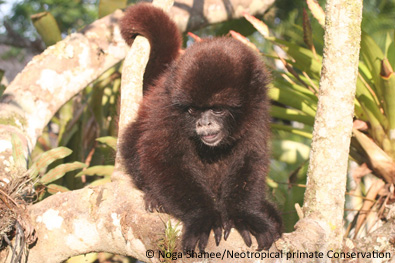The yellow-tailed woolly monkey (EDGE Mammal number 79) is one of the largest and rarest New World monkeys. It is only found in the tropical forests of the western slopes of the Andes Mountains in north eastern Peru. In 1999 it was thought that only 250 individuals still survived in the wild. The species is listed by the IUCN as Critically Endangered and features on the current list of the world’s top 25 most endangered primates. In fact, this species is so rare that many people thought it was extinct until it was rediscovered in the mid 1970’s by a team of Peruvian and American biologists.
So little is known about this species that there is still debate as to whether it is of the same genus as the other woolly monkeys, Lagothrix, or whether it is the only representative of another genus altogether, Oreonax. The forests where the yellow tailed woolly monkey live have among the highest deforestation rates in Peru and it is estimated that half of its limited habitat has been lost in the last 25 years.
Since 2007 the British NGO Neotropical Primate Conservation has been working in the Amazonas and San Martin departments of Peru to try and bring this species back from the brink of extinction. Working together with the Natural History Museum of San Marcos University in Lima and the National University of Amazonas the work has focused on increasing knowledge of the yellow tailed woolly monkeys’ actual situation. This includes finding out which areas are most critical to its conservation and what actions are most needed in these areas.
So far the project has instigated native species reforestation programs with the construction of six nurseries to try and increase the species habitat and reduce pressures on the remaining area of forest. Also, environmental education programs for school children and adults have begun, with Peruvian university students and international researchers voluntarily teaching the importance of conservation in some of the remotest villages in the region.
Aside from this, the project is trying to develop sustainable economic alternatives for the local people to replace the current illegal logging and cattle ranching which forms the main income in the area. Alternatives being developed include eco-tourism, the sale of handicrafts and the cultivation of shade grown agriculture which leaves the forest intact.
The final aim of the project is to create a network of reserves and protected areas in the region to ensure the survival of the species. This network will include the formation of a group of local institutions responsible for ensuring the reserves receive on the ground protection and supervision, and not just stay on paper. The first reserve application is set to be made to the national government in the next few months; this reserve will encompass 3,000 ha of primary cloud forest on the border of Amazonas and San Martin. Another area of 10,000 ha has already been set aside as a reserve by local people to the north and several other potential reserves have been identified.
The yellow tailed woolly monkeys’ survival is important, not only as it is one of the most charismatic of our closest relatives, but as it inhabits forest which is home to many other endangered species which will also benefit from the creation of new reserves and other conservation work.
More information can be found at www.neoprimate.org, including regular news blogs and details on how you can help, support and volunteer on this project.
Sam Shanee, Neotropical Primate Conservation.
